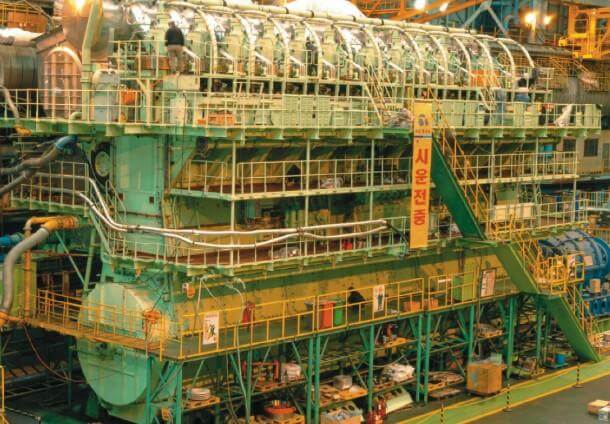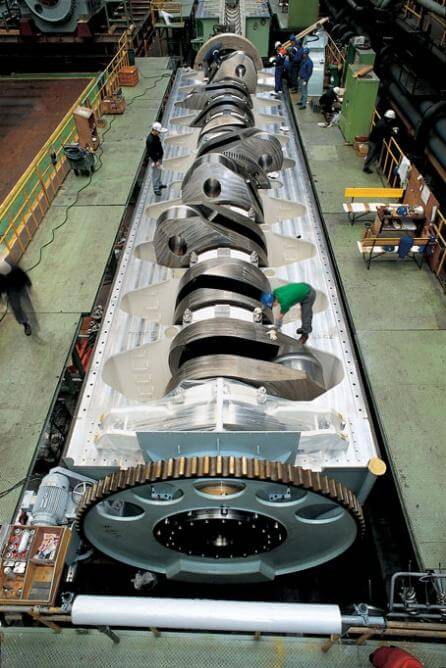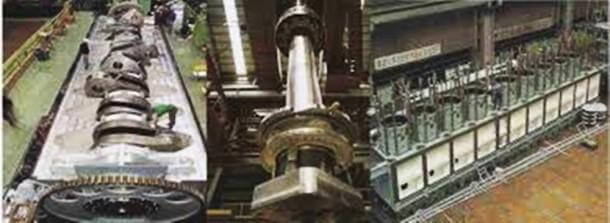Have your first look at Wärtsilä RT-flex96C, the world’s largest and most powerful diesel engine in the world today.
Yes, isn’t it awe inspiring and amazing? Manufactured by a Finnish company known as Wärtsilä, this engine is capable of producing 80080 KW power, enough to charge an entire suburban town. The magnificent engine weighs an astounding 23,000 tons. It is a two-stroke turbo charges low speed engine.
Are you wondering where exactly will this huge intimidating machine be used? For a long time now, shipping has proved to be the most efficient form of trade. Just for your information, these massive trading ships weigh thousands of tons and go at decent speeds of more than 35 knots. To provide such huge engine power, the engine has to be robust. The Wärtsilä RT-flex96C will provide all that power and more. The engine has been put into use in September 2006 at Emma Mærsk.
The huge engine has 14 built-in cylinders that consume about 6.5 ounces of diesel in one cycle. Each cylinder is capable of producing about 5700 kW of energy. The design is similar to the RTA96C engine however, the traditional camshaft, hydraulic actuators and pumps have been replaced by the all new state-of-the-art rail technology. The engine speed varies from 22-102 rpm.
The efficient Wärtsilä RT-flex96C can consume 170 g/kWh and has bore of 960 mm. It is also environment friendly and does not release excessive amounts of harmful GHG emissions. The engine is highly efficient and is considered the largest reciprocating engine in the world.
The Wärtsilä RT-flex96C is undoubtedly a wonder of modern engineering. The huge machine is capable of powering any size of ships and its 14 built-in cylinders cater for huge amount of power demands. The remarkable engine is 44 feet tall and 90 feet long.
The ships that transport goods from China to the U.S. are usually Huge. And when we say huge, we are talking about ships weighing 180,000 tons each and 1300 feet or more in length. A lowly, measly turbo engine cannot even move these gigantic ships. The Wärtsilä RT-flex96C diesel engine produces 109,000 horsepower of energy that runs such ships. Currently, there are about 25 of these huge engines out there in our oceans and 86 more are coming soon. The improved fuel economy, longer life spans and better engine performance ensure bright future prospects for the huge Wärtsilä RT-flex96C engine.








How big is the battery to start that engine?
why not use nat gas, LNG or even steam as a mid-size muni power plant? put one on/in a steel water proof container and dock it in Puerto Rico ASAP. thanks. oh, ps., bill DJFtrumph..
Whats the MPG on this bad boy?
Customization, customer service and most importantly profitability are reasons why DIRECTV is
a transparent favorite among businesses nationwide.
an engine thats weighs 23000 tons and only produces 109000 horsepower? seriously? a turbine engine that powerful weighs far less and would allow more cargo, not to mention being more reliable and far simpler to maintain. looks like low tech rules the waves
Good point! These specs calculate out to (109000/23000 = ) 4.74 HP per ton! This is 4.74/2000 = .00237 HP per pound
The GE LM2500+ Marine Turboshaft gas turbine cranks out 40,500 HP at .8 HP per lb. This is .8/.00237 = 338 times the power to weight ratio of the RT-flex96C. My guess is that at 109000 HP, there might be reliability or MTBF issues with the gas turbine.
There is a huge issue with just making an engine bigger. To the point it’s weight will out-way its power. But if you need 100,000 HP this is the best way to do it. Turbines that big would detonate to quick being too expensive to keep replacing.
Detonate? You don’t know what you’re talking about.
Turbines power several cruise ships, so size is not an issue. Multiple engines ensure redundancy and the capacity for powerplant changeout under sail, so replaceability and serviceability is not an issue. Turbines power over 90,000 commercial aircraft flights every day around the globe, so reliability is not an issue. Turbines power large commercial passenger jets travelling at 600 mph, so high speeds and your imaginary ‘detonation’ are not an issue.
Fuel efficiency is the deciding factor, as diesel has a slight advantage which compounds over many years and many miles.
Remember that with all that power comes the need to contain it. We just do not have materials strong and cost effective enough to make a light weight engine that big. You want a massive crankshaft to keep rotating when loaded with water against a propeller. And you need a massive wall of steel to keep the crankcase and block from cracking due to mechanical forces–and fatigue. Yes a gas turbine would be more powerful per pound but can you imagine the heat and noise you would have to deal with? Not to mention the machining cost of parts. Also, this is for a ship not an aircraft where weight is a much greater concern. The buoyant force of the large vessel is part of the design weighing cost against pure performance. I am sure there are many other considerations to contend with with something over 100K horsepower. Cost per HP over the life of the engine being the main one.
Neither heat nor noise are limiting factors in the use of turbines in nautical applications. Several large cruise ships currently at sea employ turbine propulsion. Exhaust heat recovery is employed in both engine types. Long intake and exhaust routing in large vessels makes turbine noise supression engineering a routine exercise. I can provide examples where high thrust class (large) turbine engine test facilities utilizing very short noise supression ducting, are located in close proximity to residential zoning, with low to zero impact.
Dude… Torque!!! Come on…
Spelling mistake I guess – it weighs 2300 tons according to Wikipedia. Also the Wärtsilä states service speed of 25 knots, which is still very fast for a cargo ship.
Since you know so freaking much apply for a job there and change the world of shipping ! Or just shut up and be amazed at how awesome of a mechanical engineering accomplishment this was!
Btw these companies employee really really smart people that compare all aspects of all matters while making the decision to invest Millions of dollars on devices to make them millions more dollars, so in the end they are right, super smart, rich as hell and your just a dumbass on a comment board!!
Low rpm… Did you see the torque figures on this beast?!!!
I know well WARTSILA DIESEL It is a Giant and wonderful technological in engineering field.
Amazing to see such a big engine made by mechanical engineers. I am proud to be an engineer.
BIG and BAD! AWESOME! I am a Civil Engineer and Aerospace Engineer and I LOVE this website. I see all the newest and biggest and baddest devices, machines, electronics, engines, vehicles, and so many other things here. I never can get enough of this website. It is so good to have one place tocome to and see it all.
mechanical engineer “GRATE”….!!!
I’d love to see the turbos this engine uses!
The low speed is crucial to the high thermal efficiency, meaning the engine has more time to use the generated heat from the fuel. Very cool engine! 😀
2 stroke diesel engines use superchargers to push air into the engine, otherwise it will crank but not fire
engineering skills,professionaly of aoquiring and applying scientific.in order to design and also build structure machines.amazing and wonderful.
Very nice, and big images, I love it.
now engineers made world
amazing technology
Aweome! Wartsila keep going 😉
What made
Wonderful Engineering
Whath can mad